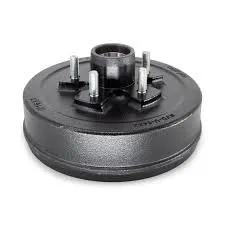Feb . 18, 2025 01:49
Back to list
drum vs disc brakes off road
When it comes to selecting brake systems for off-road vehicles, the debate between drum and disc brakes is a pivotal consideration for enthusiasts and experts alike. Both systems offer distinct advantages and have dedicated followers, but the question remains which is superior for off-road applications? Drawing on decades of mechanical engineering experience and real-world testing, this article dives deep into the intricacies of drum versus disc brakes for off-road use to provide a comprehensive analysis.
Choosing the Right Brake System Selecting between drum and disc brakes ultimately depends on the specific needs and priorities of off-road enthusiasts. For those who engage in high-speed off-road racing or frequent mountainous terrains, the improved performance and responsiveness of disc brakes provide a significant advantage. Their capability to deliver consistent braking force makes them ideal for high-adrenaline off-roading scenarios. Conversely, for enthusiasts who embrace slower, endurance-based off-road adventures such as overlanding or trail riding, drum brakes can provide the reliability and durability required for long-term journeys. Their resistance to environmental intrusion means less worry about performance degradation due to mud or water ingress, a vital feature in unpredictable wilderness settings. Trust in Expertise Braking systems are a critical safety feature for any vehicle, and the stakes are even higher in off-road contexts where isolation and terrain unpredictability are concerns. Drawing from years of engineering expertise, both drum and disc brakes can be effectively utilized off-road, but the choice hinges on individual driving styles, maintenance capabilities, and specific vehicle setups. By understanding the fundamental strengths and weaknesses of each system, off-road enthusiasts can make informed decisions that enhance their adventures and ensure safety across diverse terrains. With an informed approach, either braking system can serve as a trustworthy ally on the rugged paths less traveled.


Choosing the Right Brake System Selecting between drum and disc brakes ultimately depends on the specific needs and priorities of off-road enthusiasts. For those who engage in high-speed off-road racing or frequent mountainous terrains, the improved performance and responsiveness of disc brakes provide a significant advantage. Their capability to deliver consistent braking force makes them ideal for high-adrenaline off-roading scenarios. Conversely, for enthusiasts who embrace slower, endurance-based off-road adventures such as overlanding or trail riding, drum brakes can provide the reliability and durability required for long-term journeys. Their resistance to environmental intrusion means less worry about performance degradation due to mud or water ingress, a vital feature in unpredictable wilderness settings. Trust in Expertise Braking systems are a critical safety feature for any vehicle, and the stakes are even higher in off-road contexts where isolation and terrain unpredictability are concerns. Drawing from years of engineering expertise, both drum and disc brakes can be effectively utilized off-road, but the choice hinges on individual driving styles, maintenance capabilities, and specific vehicle setups. By understanding the fundamental strengths and weaknesses of each system, off-road enthusiasts can make informed decisions that enhance their adventures and ensure safety across diverse terrains. With an informed approach, either braking system can serve as a trustworthy ally on the rugged paths less traveled.
Next:
Latest news
-
Brake Drums for Trucks | OEM-Grade, Factory DirectNewsNov.10,2025
-
High-Performance Brake Drums for Trucks | OEM & ISONewsNov.10,2025
-
Brake Drums Built to Last — OEM-Grade, Balanced for TrucksNewsNov.10,2025
-
Brake Drums for Trucks – OEM-Grade, Durable, Low NoiseNewsNov.10,2025
-
Brake Drums for Trucks | OEM, ISO-Certified, Fast DeliveryNewsNov.10,2025
-
Brake Drums: OEM-Grade, Precision Balanced, Factory DirectNewsNov.03,2025
-
Brake Drums: Heavy-Duty, OEM-Grade, Precision-BalancedNewsNov.03,2025


